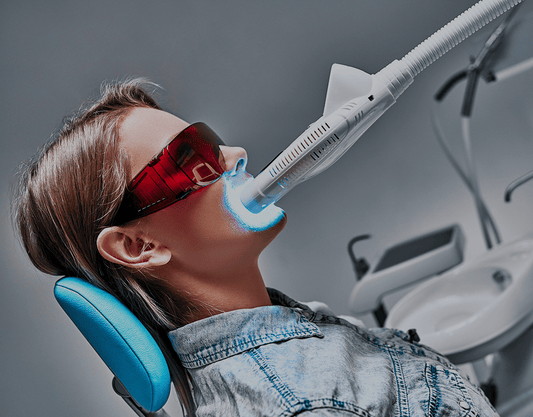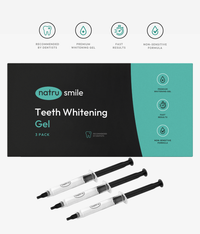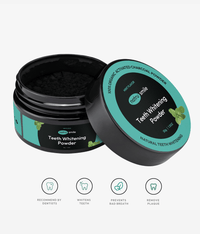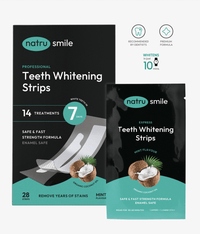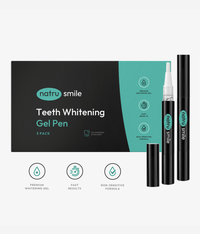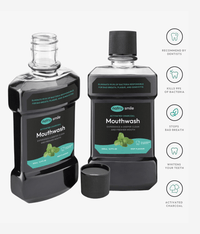
All products are certified by dental expert Dr. Greg Grillo
Having white teeth is an important part of looking and feeling your best. Unfortunately, not everyone has perfect pearly whites due to a variety of factors such as genetics, aging, or lifestyle choices.
If you’re searching for ways to brighten up and improve your smile without spending too much time and money in the dentist's chair, then laser teeth whitening and Zoom (manufactured by Phillips) are two options that you may want to consider.
Both cosmetic dentistry treatments provide excellent results, but they do have some differences that can help distinguish which procedure is right for you. Read on to learn more about Zoom vs laser teeth whitening.
Zoom Whitening Vs Laser Whitening: A Quick Overview
This type of in-office teeth whitening uses a light-activated bleaching gel to break up the molecules of discolored material on your teeth and make them appear brighter. It can be completed in just one session, and you'll see results almost immediately, although some people might need multiple treatments to achieve their desired shade.
Laser whitening is also done at the dentist's office, but instead of using a bleaching gel, it uses a special laser light to activate the hydrogen peroxide in the whitening solution. The laser helps penetrate deep into the tooth enamel and remove stubborn stains that regular whitening methods may not be able to tackle.
Typically, certain types of people opt for each procedure, depending on their individual needs. Zoom whitening is best for people who want to see fast results with minimal hassle. Laser whitening is great for those who want long-lasting results and are willing to invest in a more expensive treatment.
Zoom Whitening For Your Teeth: How Does It Work?
While laser teeth whitening is purely an in-office treatment, there are numerous types of Zoom whitening treatments. They include professionally-done treatments at the dentist’s office and take-home treatments after a consultation. All of these teeth whitening options involve a chemical solution, but other than that, the procedures themselves vary.
Let’s take a closer look at each option below:
Zoom WhiteSpeed
The most effective Zoom option is the Zoom WhiteSpeed in-office procedure. It involves using a special bleaching gel that contains 25% hydrogen peroxide and is activated with an LED. The gel also contains amorphous calcium phosphate, which protects the enamel and reduces tooth sensitivity.
The light helps break up the molecules of discolored material but also works to whiten the dentin - the layer just below the enamel - which helps your teeth look even brighter. It can be done in just one 45-minute session, although some people may need or want more than one treatment to achieve their desired shade.
The results are usually visible immediately after the procedure, and your dentist will provide aftercare instructions and at-home teeth whitening materials.
Zoom QuickPro
As evident by its name, Zoom QuickPro is the faster version of Zoom Whitening. It typically takes only 30 minutes and involves a lower concentration of hydrogen peroxide (15%) than WhiteSpeed, making it ideal for those who are looking to just touch up their teeth rather than completely revamp them.
Unlike WhiteSpeed, QuickPro doesn’t use an LED. Your dentist will simply apply the whitening substance and add a sealant on top of that for protection. Half an hour after the procedure, you’ll be required to brush the substance off.
The results with QuickPro can also be seen right away, but they may not last as long as with WhiteSpeed.
At-Home Zoom Whitening Treatments: Zoom DayWhite And Zoom NiteWhite
If you don’t have serious staining or prefer a more gradual treatment option, then Zoom DayWhite or NiteWhite may be for you. You can also opt to use these treatments after an in-office treatment for more aggressive results.
Both treatments involve using custom-fitted trays that contain lower concentrations of hydrogen peroxide than WhiteSpeed or QuickPro. But keep in mind they’re still a lot more powerful than teeth whitening kits from the store.
DayWhite involves wearing the trays for a period of 30 minutes to 90 minutes during the day, while NiteWhite can be worn for 2 to 4 hours or overnight while sleeping. Both require daily use for two weeks.
You’ll need to visit the dentist to get the impressions done of your teeth and for the dentist to show you how to perform the at-home treatment. They’ll also recommend the right product for you: NiteWhite comes in 10%, 16%, and 22% carbamide peroxide gel options, and DayWhite comes in 9.5% and 14% hydrogen peroxide options.
Laser Whitening For Your Teeth: How Does It Work?
On the other side of the equation is laser teeth whitening. It also involves applying a special bleaching gel directly to the tooth enamel, but instead of an LED, it’s activated with an intense laser light beam.
The heat from the laser is what targets the staining molecules on your teeth this time, resulting in a brighter shade after just one session. The laser teeth whitening treatment usually takes about 30 minutes to 1 hour to complete, and you can expect some sensitivity immediately afterward, although this should subside within a few hours.
Your dentist will protect your eyes and gums with protective glasses and a gum barrier. Unlike Zoom treatments, you won’t be given any at-home materials to take away with you.
Differences Between Zoom Whitening And Laser Whitening: A Breakdown
It's time to get down to the fine details. Here's a quick breakdown of the difference between laser and zoom teeth whitening in terms of cost, effectiveness, convenience, and more.
Results
When it comes to the results, both treatments can produce impressive whitening results that last for a long time. Generally speaking, results will last an average of a few months to over a year. A retrospective study found that results from Zoom WhiteSpeed followed by Zoom DayWhite treatment lasted 12 to 15 months. This suggests that combining both treatments might be the best option.
On the other hand, laser teeth whitening can provide results that last a few months up to three years. The reason is that the laser helps to penetrate deeper into the enamel, which helps the whitening gel to be more effective and longer-lasting.
Results, like for anything, will also depend on the individual. Despite which procedure you choose to go for, maintaining good oral hygiene practices, following your dentist’s aftercare instructions, and making lifestyle adjustments will help preserve the whiteness of your teeth.
Cost
Cost-wise, Zoom whitening cost is often slightly cheaper than laser teeth whitening. The cost of Zoom QuickPro hovers around $125 - $150 but goes up to around $500 for QuickPro. If you’re on a budget and worried about teeth whitening costs, Zoom DayWhite or NiteWhite might be more suitable for your situation - costing less than $100.
Laser teeth whitening cost usually ranges between $400 and $1,500, with some dentists charging as much as $1,800 for the procedure.
Effectiveness
Both treatments are very effective, but laser teeth whitening may be slightly more effective than Zoom whitening for more severe cases. Seeing as the laser helps to penetrate deeper into the teeth enamel, it helps the whitening gel to work faster and produce better results.
They’re both able to whiten your teeth by several shades in a single session. With Zoom WhiteSpeed, you can expect your teeth to become up to eight shades whiter after the first treatment. Laser teeth whitening can produce even better results, with some people claiming that their teeth were up to 15 shades lighter after just one session.
Time
Regarding the teeth whitening duration, there is no clear winner between these two treatments. With Zoom whitening, the entire procedure can be completed in a single visit to the dentist's office and usually takes no more than an hour. Similarly, laser teeth whitening is done in just one visit and takes 30 minutes to an hour for the session.
Convenience
Both treatments are relatively convenient and easy to schedule with your dentist in-office. Zoom has the advantage of offering at-home treatments for those who want more convenience and less apparent results. For this, you will need to make sure that you follow the instructions given to you and consistently wear the molds daily.
Sensitivity
When it comes to sensitivity, there is a big difference between the two treatments. Zoom whitening is known for causing more sensitivity than laser teeth whitening due to the higher concentration of hydrogen peroxide used in the treatment. The chemical may cause some discomfort, sensitivity, and twinges after the procedure. This is because the enamel is weakened temporarily and will need time to harden again.
For laser whitening, you might experience some mild sensitivity, especially to overly hot or cold food and drink. But, like Zoom, the discomfort should resolve itself pretty quickly. As the procedure uses a strong bleaching agent along with intense lasers, it may cause more of a throbbing pain.
It’s normal to feel some sort of pain and sensitivity right after treatment or even the day after. Temporary sensitivity shouldn’t be a deterrent to teeth whitening.
Safety
Teeth whitening safety is generally not an issue. The procedures have minimal side effects as long as they're done by a qualified professional. However, it's important to talk to your dentist beforehand to make sure that either treatment is suitable for you and won't cause any harm or discomfort.
Laser And Zoom Teeth Whitening: Similarities
These procedures aren't entirely different. Here are some similarities between the two treatments:
Both Use Hydrogen Peroxide Gel To Whiten Teeth
Both treatments rely on a similar concept. A special whitening gel is applied to the teeth, and then light or laser energy is used to activate the gel and break down tough stains.
Both Rely On Oxidation To Seep Into The Dentin
All teeth whitening procedures work through a process called oxidation. To look at it with an example, imagine a banana turning brown. This is oxidation; the same process happens with teeth whitening treatments, as the gel helps to penetrate into the dentin and remove discoloration.
The stains on your teeth are essentially a mass of molecules, and once scattered through the whitening gel or substance, the area becomes lighter in color.
Laser Teeth Whitening Vs Zoom: Which Is Worth It?
So, which treatment should you choose? Laser teeth whitening and zoom Whitening, as demonstrated, both have their own benefits and drawbacks. If you want an efficient way to get your teeth whitened quickly with longer-lasting results, then laser teeth whitening may be the best option for you. On the other hand, if convenience is a priority, then Zoom whitening might be the better choice. Focus on your budget, preferences, and lifestyle when deciding on which treatment is right for you.
Laser Teeth Whitening Vs Zoom: Which Will Last Longer?
If you’re wondering which treatment will last longer, laser teeth whitening is the clear winner. As mentioned above, results from laser teeth whitening can last up to three years, while Zoom WhiteSpeed (the most effective Zoom option) typically only lasts 12-15 months when combined with other treatments.
Looking for answers to more of your questions on teeth whitening? We’ve answered some frequently asked questions below.
How Long Does Whitening Teeth With Zoom Take?
The Zoom teeth whitening process takes about 45 minutes to an hour to complete but is broken up into smaller “sessions” within this time. During the procedure, your dentist will apply a special gel on your teeth before each session and then activate it with the LED.
Do You Brush Your Teeth After Zoom Whitening?
You are required to brush your teeth after Zoom whitening to remove any leftover hydrogen peroxide or bleaching agent. It’s also crucial that you use the at-home post-treatment materials given to you by your dentist. As well, be sure to brush at least twice a day and use mouthwash regularly in order to keep the effects of the treatment lasting longer.
How Long After Zoom Whitening Can I Drink Coffee?
It’s recommended to wait at least 48 hours after your Zoom whitening procedure before drinking coffee or any other dark-colored beverage. Since these beverages are prone to staining, it can be beneficial to rinse your mouth after drinking.
Does Zoom Teeth Whitening Hurt?
The Zoom teeth whitening procedure typically doesn't cause a lot of pain. Many patients report feeling a slight tingling sensation during and after the treatment, which is considered to be normal and will resolve after several hours.
Is Zoom Whitening The Same As Bleaching?
For Zoom whitening vs bleaching or laser teeth whitening vs bleaching, all use a form of peroxide to remove stains from the teeth. However, Zoom uses a higher concentration of peroxide than traditional bleaching. As a result, it can produce more dramatic results in less time.
Can You Swallow During Zoom Whitening?
No, you should not swallow during a Zoom whitening treatment. The hydrogen peroxide used in the procedure is highly concentrated and can cause nausea or other undesirable side effects if ingested.
How Soon Can I Eat After Zoom Whitening?
You can start eating non-pigmented and room-temperature or warm foods a few hours after your procedure. When it comes to dark-colored food and drink, try to avoid consuming these until at least 48 - 72 hours after the procedure.
This is because Zoom whitening uses a bleaching agent that can be damaged by certain food and drinks, so you’ll want to give your teeth enough time to heal before you eat or drink anything acidic.
How Many Shades Whiter Does Zoom Make Your Teeth?
The beauty of Zoom is that you can choose how white you want your teeth to be. Most patients choose to lighten their teeth between five and eight shades.
Is Zoom Whitening Better Than Trays?
When you compare the two, you’re essentially comparing in-chair vs teeth whitening products. Zoom is more effective than traditional tray-based treatments, as it can lighten your teeth up to eight shades in just one appointment. It also eliminates the need for custom trays and does not require multiple visits. The downside is that Zoom can be more expensive than tray treatments.
Zoom also offers at-home teeth whitening in the form of custom-fitted whitening trays, which provide similar results but at a lower cost. They differ from those you can buy on the shelves in that you have to visit a dentist and get them custom fitted for your mouth.
Does Zoom Whitening Destroy Enamel?
No, Zoom whitening is safe and does not damage tooth enamel. The procedure uses a low-concentration hydrogen peroxide gel that breaks down deep-set stains without causing any harm to the teeth. It may make your teeth feel sensitive for a few days from opening up the pores in the enamel, but this should subside with time.
How Many Rounds Of Zoom Whitening Should I Do?
The number of rounds you should do will depend on the amount of staining and discoloration on your teeth. Usually, one session is enough to lighten your teeth by several shades. For more dramatic results, you may need two or three sessions.
What Should You Not Do After Zoom Whitening?
The main thing to do is to avoid certain foods and drinks after Zoom whitening. In particular, you should stay away from red wine, coffee, tea, dark-colored juices, and sodas, as they can stain your teeth. The same goes for overly hot or cold food and drink.
What Are The Side Effects Of Zoom Whitening?
Temporary sensitivity in the teeth is considered the most common side effect. This usually subsides within 24 hours and can be alleviated with toothpaste designed for sensitive teeth. Other very rare but possible side effects include gum irritation, blisters, and burning sensations - none of which are permanent.
Wrapping Up
So what’s the verdict when picking between laser teeth whitening vs Zoom? Both treatments are effective and safe, so it really depends on your individual situation. If you’re looking for a quick fix with minimal downtime, then Zoom whitening is probably the right choice for you. If you want more dramatic results that last longer, then laser teeth whitening may be worth investing in.
Whatever option you choose, make sure to consult with your dentist first to ensure that it’s a good fit for your personal needs. With the right procedure, you can get the bright, confident smile you’ve been dreaming of!

